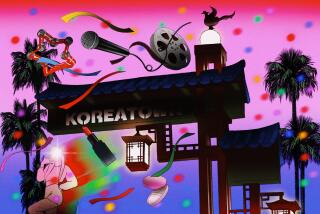A fascinating sampling of Korean culture
- Share via
At first glance, the two divisions of Korean music and dance -- court or classical and folk or popular -- look familiar to a Westerner. We might think highbrow and lowbrow or concert halls and arenas. But there are major differences, as shown in the lavish and fascinating “Presenting Korean Culture 2003” program Friday by artists from the Seoul-based National Center for Korean Traditional Performing Arts at the Pasadena Civic Auditorium.
Neither type can be fully understood out of a cultural context that links the arts to a philosophy, a symbolism of costume color and spatial position of the performers, and -- perhaps most likely to inspire envy in a time of war and trouble -- intention.
Court music is meant to be calm and spiritual, to look beyond the individual and to take nothing to extremes. Folk music is meant to be emotional, personal and vital. Neither kind of dance should be too extroverted.
The idea of a governing class having its own kind of music loses some of its sting with the notion that reflection and meditation must be part of its regimen and, by extension, must precede decision and action.
Of course, this is an ideal, but anyone who heard the opening court music selection, “Sujecheon,” which means “long life as everlasting as the sky,” could understand the idea and partake of its deep dignity and serenity. This state was achieved partly through repetition and partly through the slow tempo based on the human breathing cycle, rather than on the typically faster heart rate, as in Western music.
On the other hand, the folk music selection “Sinawi” resembled nothing so much as a wild jazz jam session in which each player not only got a chance to solo but also improvised independently throughout the piece.
Similarly, nothing could be more vital and exciting than the waves of percussive climaxes in the final “Samulnori,” a familiar stage adaptation of farmers’ outdoor music.
Almost every one of the nine selections was identified as an “Intangible Cultural Asset” and given a specific number.
The court dance “Cheoyongmu,” in which the colors of the dancers’ costumes symbolize the variation directions, for instance, was “Intangible Cultural Asset No. 39.”
Unlike Western practice, soloists were not singled out by name in the program but rather simply listed in the company roster at the back.
This is because the music, an inquiring writer was told at intermission, takes precedence over the performer.
There could be, perhaps, no greater difference between Korean and Western music than this.
More to Read
The biggest entertainment stories
Get our big stories about Hollywood, film, television, music, arts, culture and more right in your inbox as soon as they publish.
You may occasionally receive promotional content from the Los Angeles Times.










